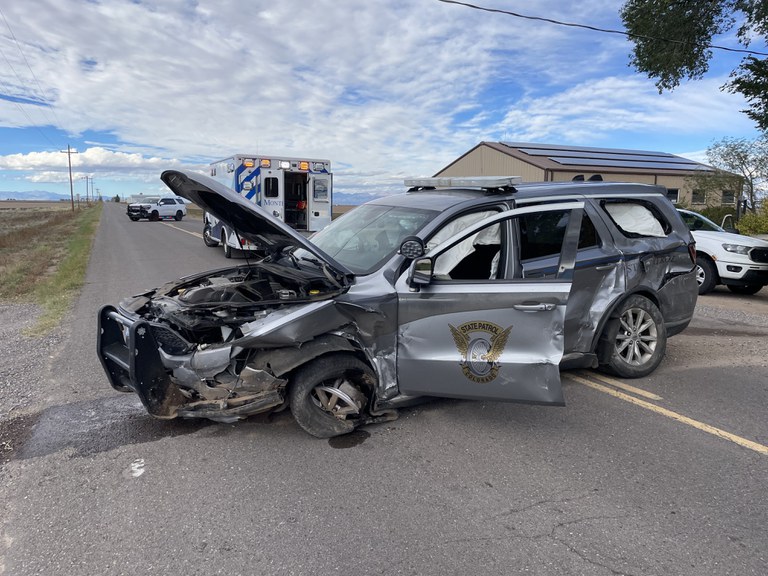Heroes on the highway: Keeping crash responders safe starts with you
News Release
For access to photos from the media kit, email [email protected].
Statewide - Today, Colorado State Patrol, the Federal Highway Administration (FHWA), and the National Highway Traffic Safety Administration (NHTSA) joined CDOT to mark Crash Responder Safety Week (Nov. 17 to 21) and raise awareness about the state’s Move Over Law and the importance of slowing down and using caution when approaching a crash scene on the roadway.
“We owe our first responders a huge round of thanks,” said CDOT Deputy Director of Operations Bob Fifer. “They are the true heroes on our roadways as they work to save lives at a crash scene. Unfortunately, far too often, drivers aren’t paying attention as they approach a crash scene and cause a second crash. We must all do our part to keep our first responders safe by slowing down and remaining alert. These responders are putting their lives on the line every day.”
Governor Jared Polis has signed a Crash Responder Safety Week proclamation, officially dedicating this week to the safety of first responders working alongside the road. The Governor’s proclamation reminds all Coloradans to be aware, look out for first responders, and slow down when they see flashing lights ahead.
To draw attention to the issue, today CSP used its training facility in Golden to simulate a crash scene, featuring a Flight for Life helicopter to underscore the seriousness of a crash scene response, where every second matters. In the demonstration, a minor crash along the side of the road turns serious when another driver causes a secondary crash, leading to extensive injuries.
"This week highlights the critical need for motorists to slow down and move over to protect our first responders and roadside workers," stated Col. Matthew C. Packard, chief of the Colorado State Patrol. "When you see lights flashing ahead, no matter the color, please create a safe workspace for these people. Crash responders show up for the fender bender to the major collisions to assist those involved and get the road open as quickly as possible."
Each year, emergency responders and highway workers are tragically struck and killed by passing motorists during secondary incidents, which can happen even during scheduled road improvement projects. CDOT collaborates with the Colorado State Patrol and other state and local responder agencies to train personnel in the latest best practices for safely and efficiently clearing incidents from the roadways. Drivers and pedestrians on Colorado roads are urged to do their part by slowing down, moving over and using caution as they pass crashes, construction zones or other areas with responder vehicles present.
According to CDOT crash data, there were 4,775 secondary crashes in Colorado from 2022 to 2024, resulting in 259 serious injuries and 43 fatalities (mainly among the drivers themselves). Secondary crashes occur when drivers strike an existing crash on the road. Such crashes are particularly dangerous for crash response teams. So far this year, there have been 1,152 secondary crashes involving 12 fatalities and 59 serious injuries.
Colorado’s Move Over Law requires drivers to move over a lane whenever they encounter any stationary vehicle on a highway with its hazards flashing — and if they can't move over, they must slow down to at least 20 MPH below the posted speed limit. Colorado’s Move Over Law is among the strongest in the country, safeguarding police, emergency responders, tow trucks, and disabled vehicles on the side of the road.
Notably, the towing industry is 15 times deadlier than all other private industries combined, according to the Centers for Disease Control and Prevention. On average, Colorado emergency workers respond to more than 100,000 crashes every year.
To reduce the risk of roadside collisions, the public can:
- Never drive impaired. Nearly a third of all roadway fatalities in Colorado involve impaired drivers under the influence of alcohol, cannabis and other drugs.
- Never drive distracted. Pay attention and stay alert. A new Colorado law prohibits drivers from using a mobile phone while driving without a hands-free accessory.
- Slow down. Reduce speed as noted in the law, but also obey speed limits and any signage posting speed reductions leading up to an incident.
- Be prepared for inclement weather. Crashes, vehicles requiring rescue, and consequently, secondary crashes increase significantly during severe winter weather conditions. All drivers and freight operators must follow Colorado’s Traction and Chain Laws.

Traffic Incident Management Training
CDOT and its partners are committed to improving traffic incident management (TIM) to detect, respond to, and clear incidents to restore traffic flows as safely and quickly as possible. Effective TIM reduces the duration and impacts of traffic incidents and improves the safety of motorists, crash victims, and emergency responders. CDOT and NHTSA offer extensive training programs for crash responders on the state and federal levels.
Crash Not Accident
Note to reporters: Crashes are no accident — they are preventable. We would appreciate you saying 'crash' instead of 'accident' when reporting.
About CDOT’s Division of Maintenance and Operations
The vision of the Division of Maintenance and Operations (DMO) is to create one integrated division. The division focus is on real-time maintenance and operations services, as well as near-term improvement projects. We can best support the crucial work of our five CDOT regions. Our support helps to provide the optimal service and safety for the traveling public in Colorado. CDOT’s DMO - we do more than you think.
Download the COtrip App!
The new free COtrip Planner mobile app was designed to meet the growing trend of information on mobile and tablet devices for the traveling public. The COtrip Planner app provides statewide, real-time traffic information, and works on mobile devices that operate on the iOS and Android platforms. Visit the Google Play Store (Android devices) or Apple Store (iOS devices) to download!
